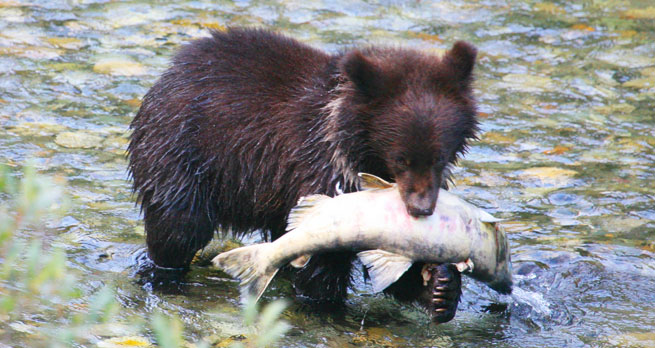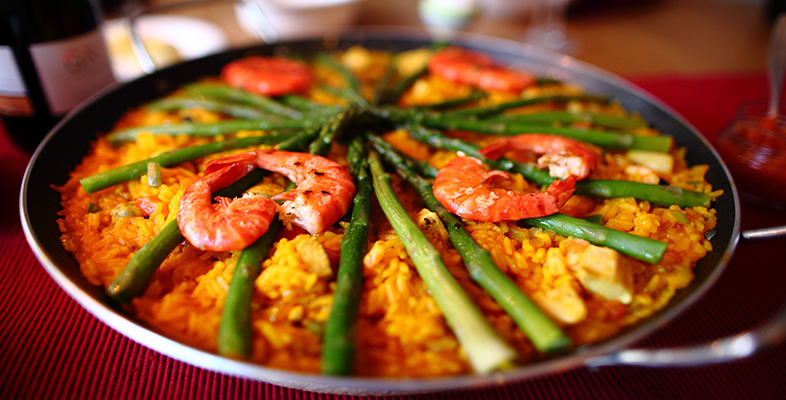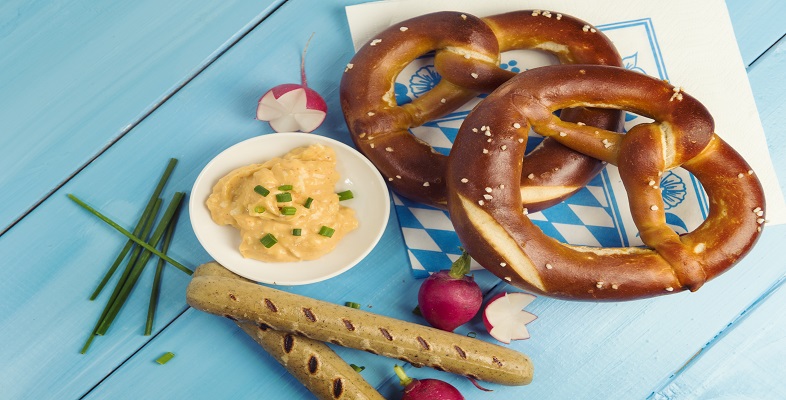The word Stör stumped us. "Maybe it's sturgeon," I suggested.
"Impossible," countered our guest, Midori. She is a well-known gourmet from Tokyo, on a visit to Munich. "Have you any idea how much a sturgeon costs?"
"Unlikely," said her husband, David, a British journalist. "Sturgeon must be on an endangered species list, somewhere."
"Besides, sturgeon isn't a fish. It's a reptile." added Master Right. "Just look at one."
 Sometimes it's easier to grab a fish than ask for it by name
Sometimes it's easier to grab a fish than ask for it by name
As luck would have it, we were at a classy restaurant in the Altstadt, with multilingual service. So we sought help.
"Can you tell me," asked David, "if this menu item is sturgeon?"
"I'm not sure," replied our waitress. "What kind of fish do you call a sturgeon in English?"
"The one that lays caviar. Y'know, sort of Russian." I had to say sort-of, since I don't know where Russia ends, nowadays.
"Actually," Dori-chan corrected, "most caviar comes from Iran."
The waitress smiled, perhaps wondering whether we wanted an answer or a conversation. To avoid the latter, she replied German. "Er kommt aus dem Schwarzes Meer."
The Black Sea. I claimed victory. "Knew it! Hope the chef squeezed its butt real good before he chopped it up."
Master Right rolled his eyes, as he often must in the company of his husband.
David frowned. "I've never eaten sturgeon before. What's it like?"
"It's ugly." answered Master Right.
"I'm not sure, but I think it's a white fish," explained his wife.
This didn't satisfy him. "We've eliminated the orange fishes like salmon, and the pink fishes like tuna. That still leaves a lot of fish."
I picked up the theme. "Is it flat and crumbly, or plump and flaky? Is it a hearty slab, or a slender fillet? Is it a DIY flip-job, like a trout? Will it stare at me from the plate?"
The waitress spotted a chance to untangle herself from what could become a lengthy debate, and went to ask the chef. Our spouses busied themselves with the rest of the menu—probably wondering about the Japanese word for rosenkohl, or the difference between a hirsch and a kirsch—while David and I pondered the fish question in greater depth.
"You know, one of our reporters invited the head of a Japanese bank to lunch in London," he began. "Mindful of our guest, the paper chose a restaurant known for seafood."
"The bank's translator opened the menu, and sighed. Fish, she said, is my personal nightmare."
I could see the point, and agreed. "When you think about it, there are many more species of fish than of other edible animals. Even in my own native tongue, I haven't a clue. What's the difference between a flounder and a halibut? What's so special aboutbarramundi? And what the hell is a sea bass?"
"Especially tough in Japanese," David reminded me, "where one finds different words for different parts of fish."
I recalled petfood commercials from Tokyo television. They warned cat-lovers that even a cat can tell the difference among parts of fish. If you don't serve him the right stuff, he'll become tired and listless.
"And it differs from place to place," I continued. "When our family first arrived in Australia, we encountered a fish and chip shop that sold different varieties of fish."
"My father saw butterfish on the menu, and cheerfully asked what it was. The lady behind the counter told him it was a pomfret. Which she thought would help, I guess."
"In the end, he ordered the cheapest item; a tasty, firm-textured fish called flake. For that evening, and many thereafter, our family dined on it. It's shark."
Master Right chimed in. "You know, meat is easy. Before the Meiji era, Japanese were farmers and fishermen. When we started to eat meat, we just borrowed English words. And not so many. Cows and pigs are simple creatures."
Our server returned, declaring that the fish was white with a bit of a pink touch, like snapper. But we had moved on to the poultry—or rather, the game. That raised even more questions.
What exactly would appear on the plate if one ordered the partridge, I asked?
"A lighter, firmer version of pheasant," answered the waitress.
I had a pork chop. It was delicious.
* * * * *
That little conversation might have stayed forgotten, had we not eaten at a Greek restaurant the other day.
It's our favourite local joint. And judging by the free ouzo, free brandy, and generousWeißbier they always pour us, we must be their favourite customers. I think they admire Master Right's appetite. For a slender fellow, he enjoys a hearty meal.
I ordered Kalimari off the German-language Speisekarte. "We have trouble with that word on our English menu," the waiter remarked, "What's English for Kalimari?"
Their English-language menu translated it as cuttle-fish. Technically correct, but it crosses the border in an English-speaker's head between fish and seafood, so the word feels odd. Many would confuse the equally correct squid with a large octopus. The octopus tentacles they serve here are Paul-sized, so this could create even more misunderstanding.
"The English word for Kalimari," I proclaimed, "is Kalimari."
This article originally appeared on Deutschland Uber Elvis under a CC-BY-NC-ND licence





Rate and Review
Rate this article
Review this article
Log into OpenLearn to leave reviews and join in the conversation.
Article reviews